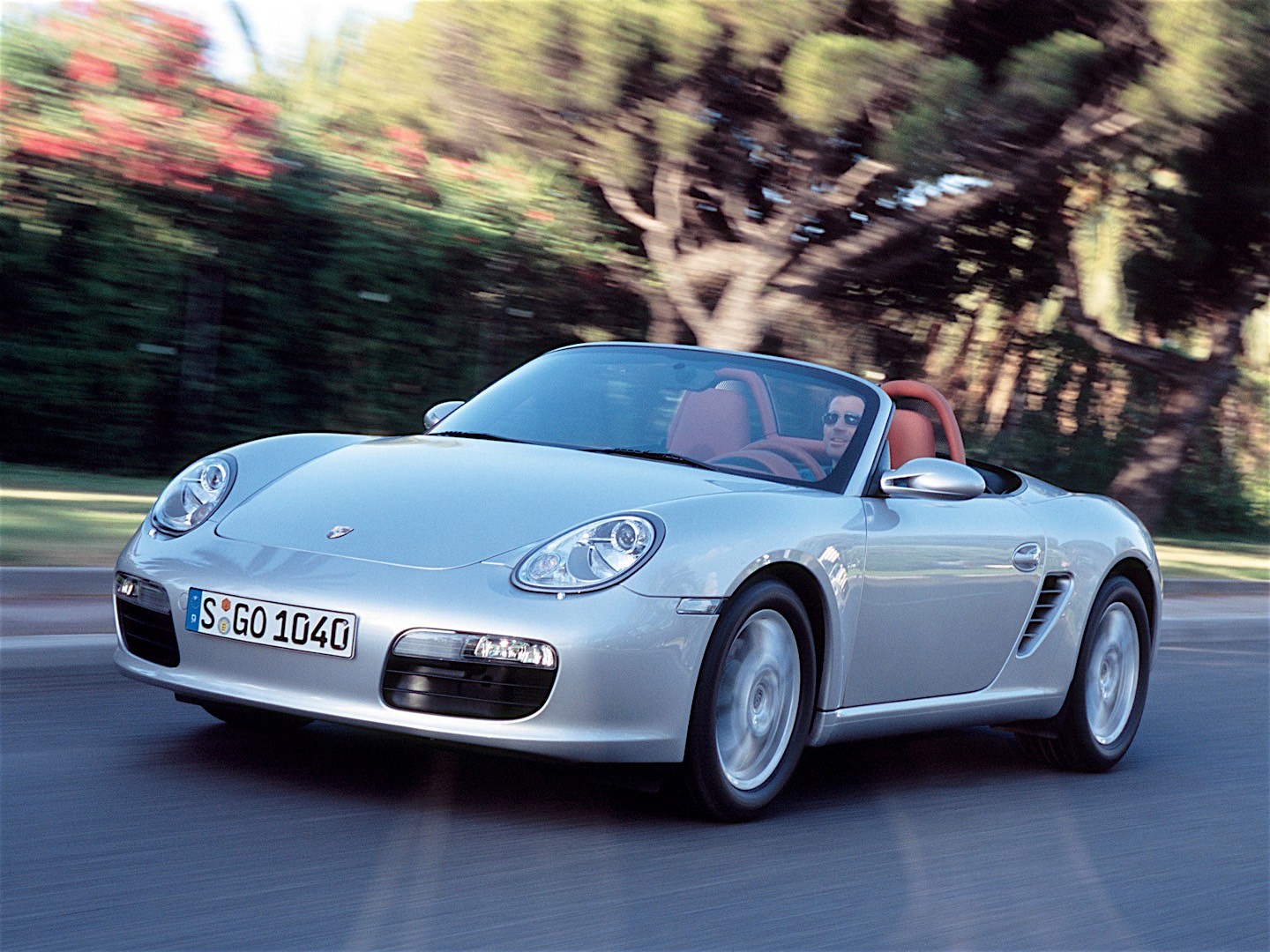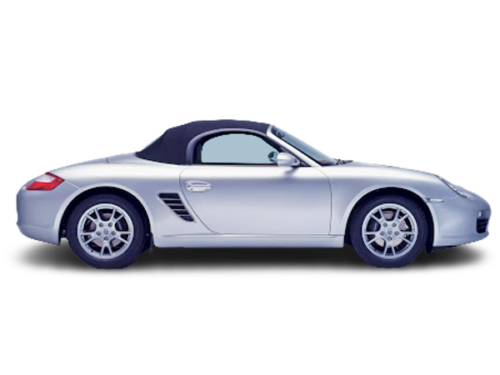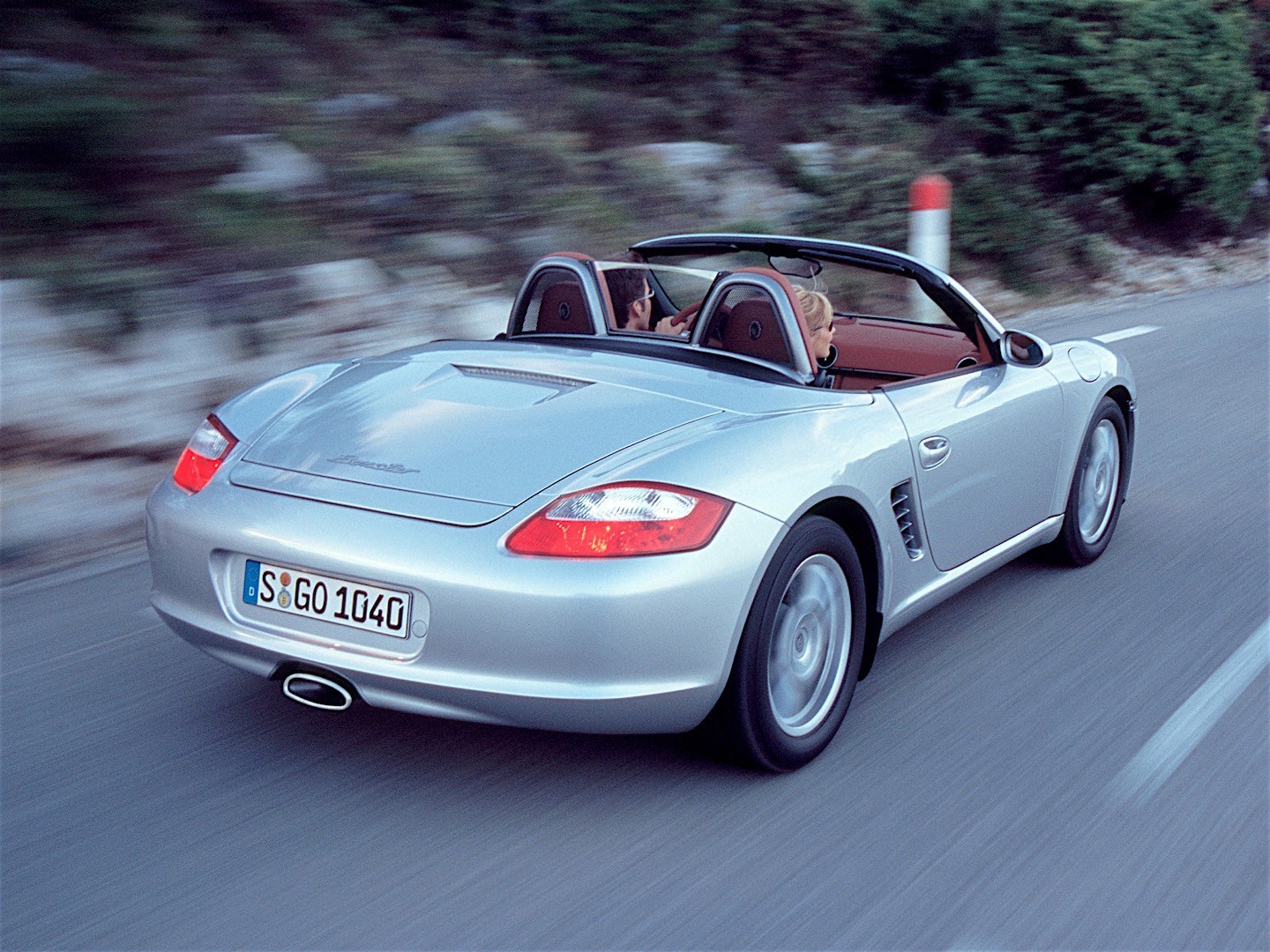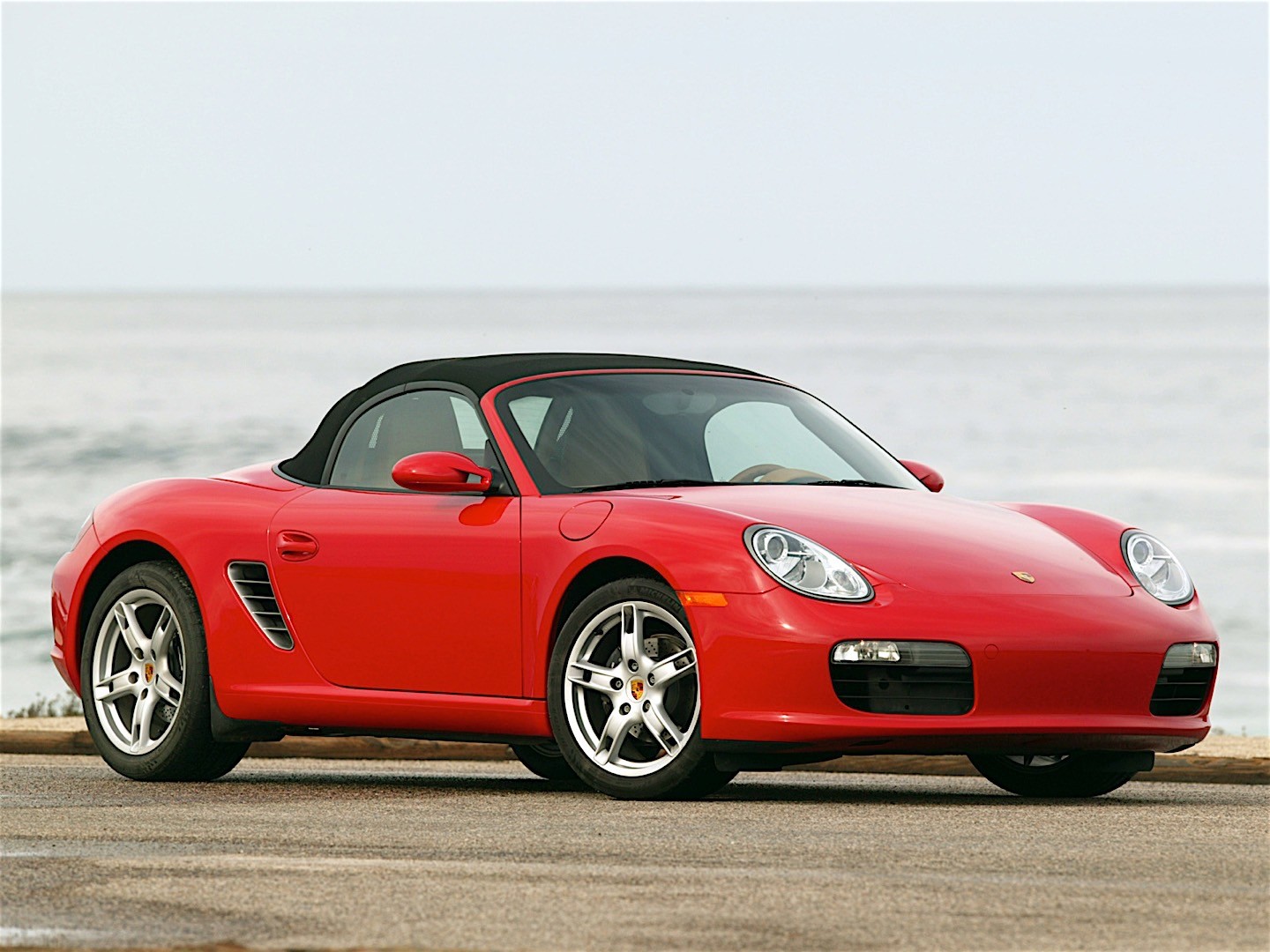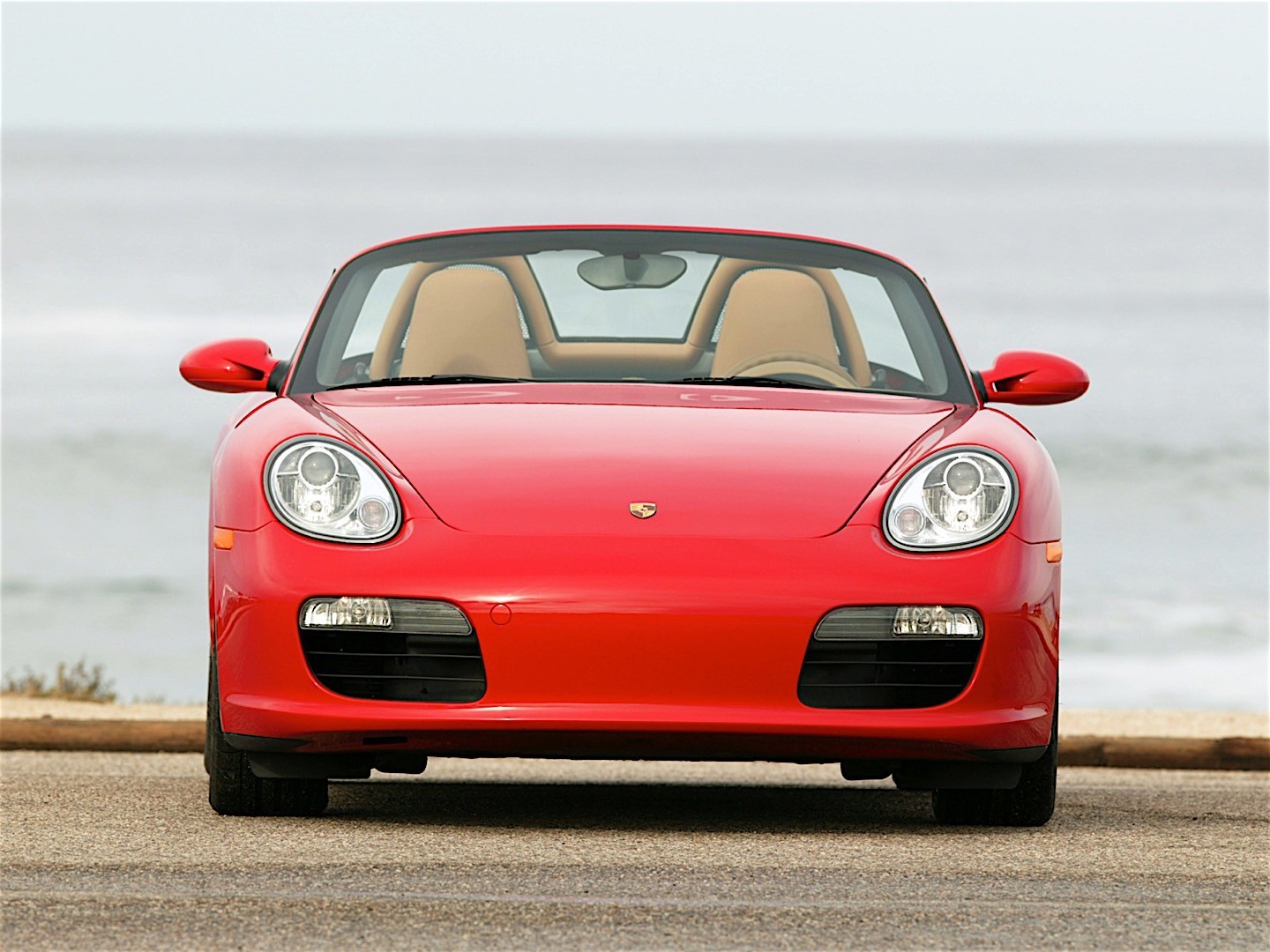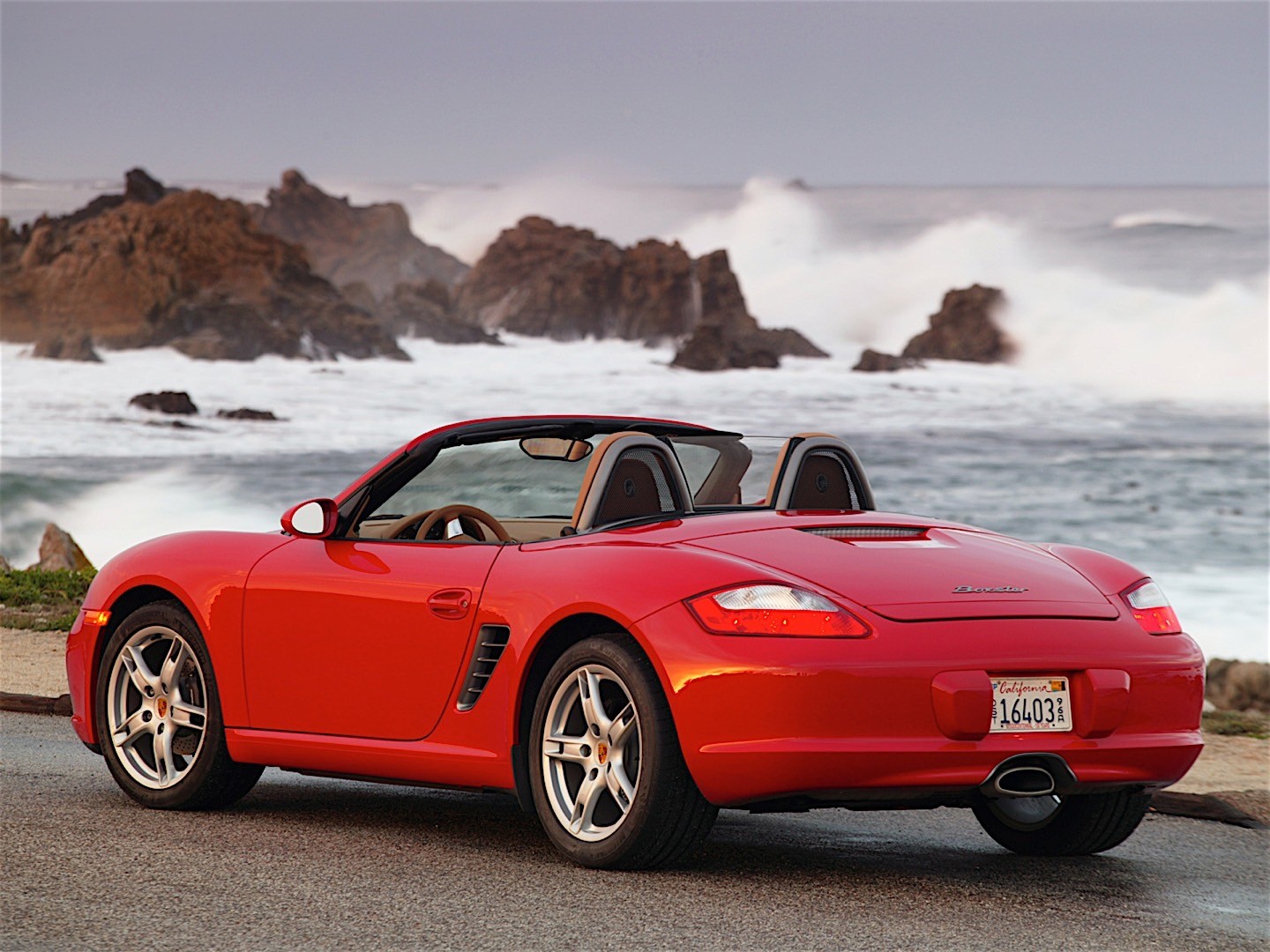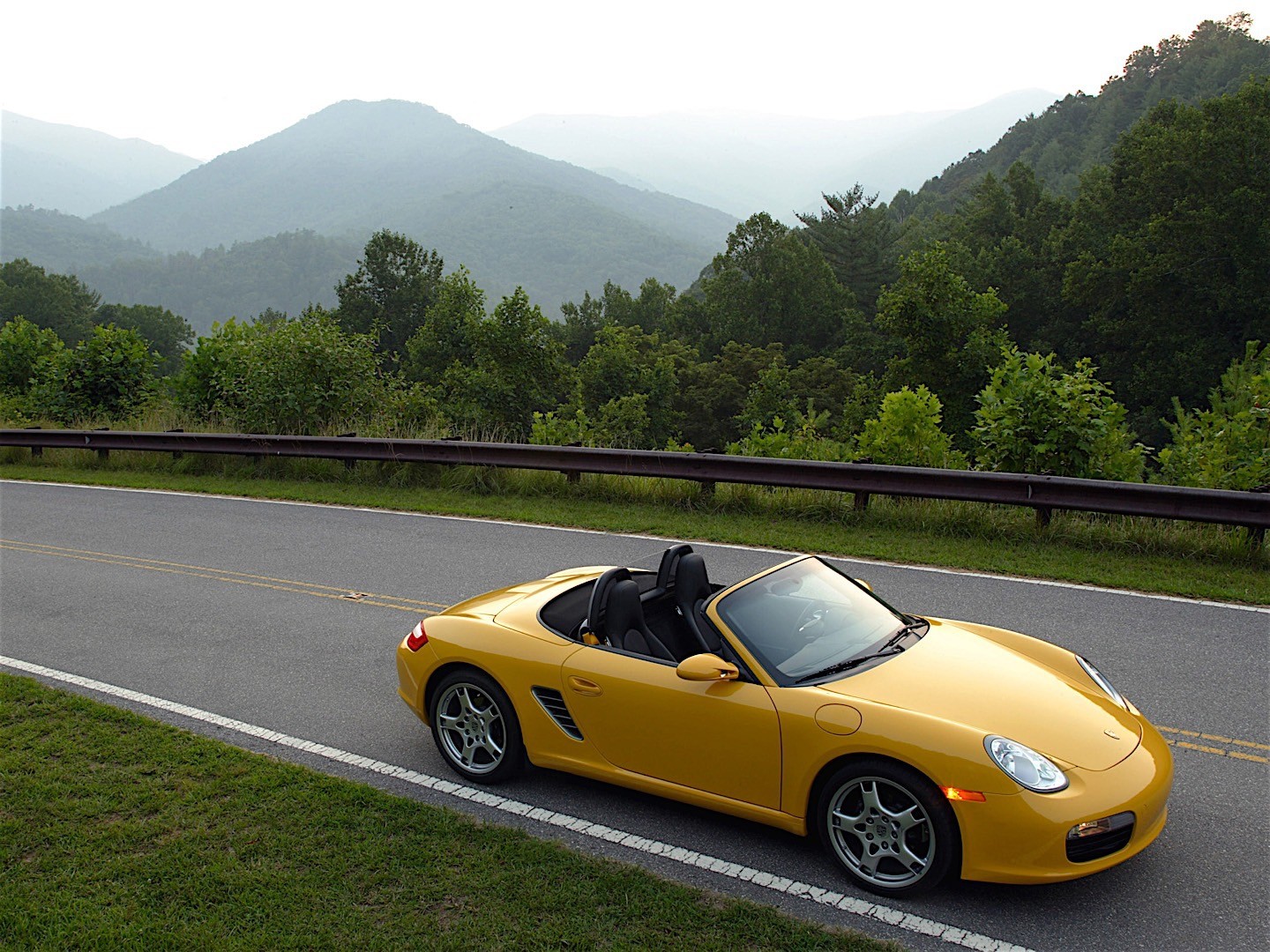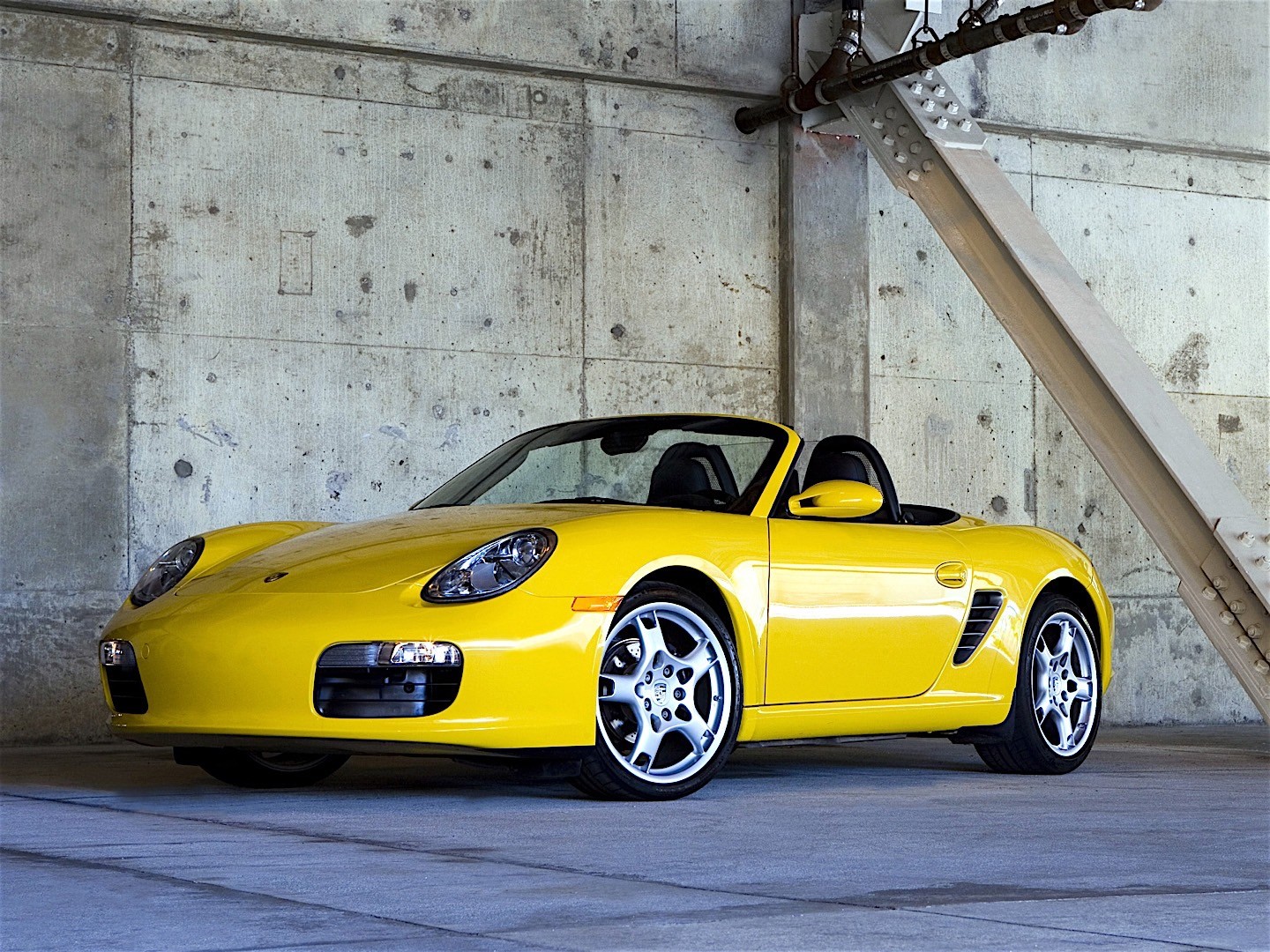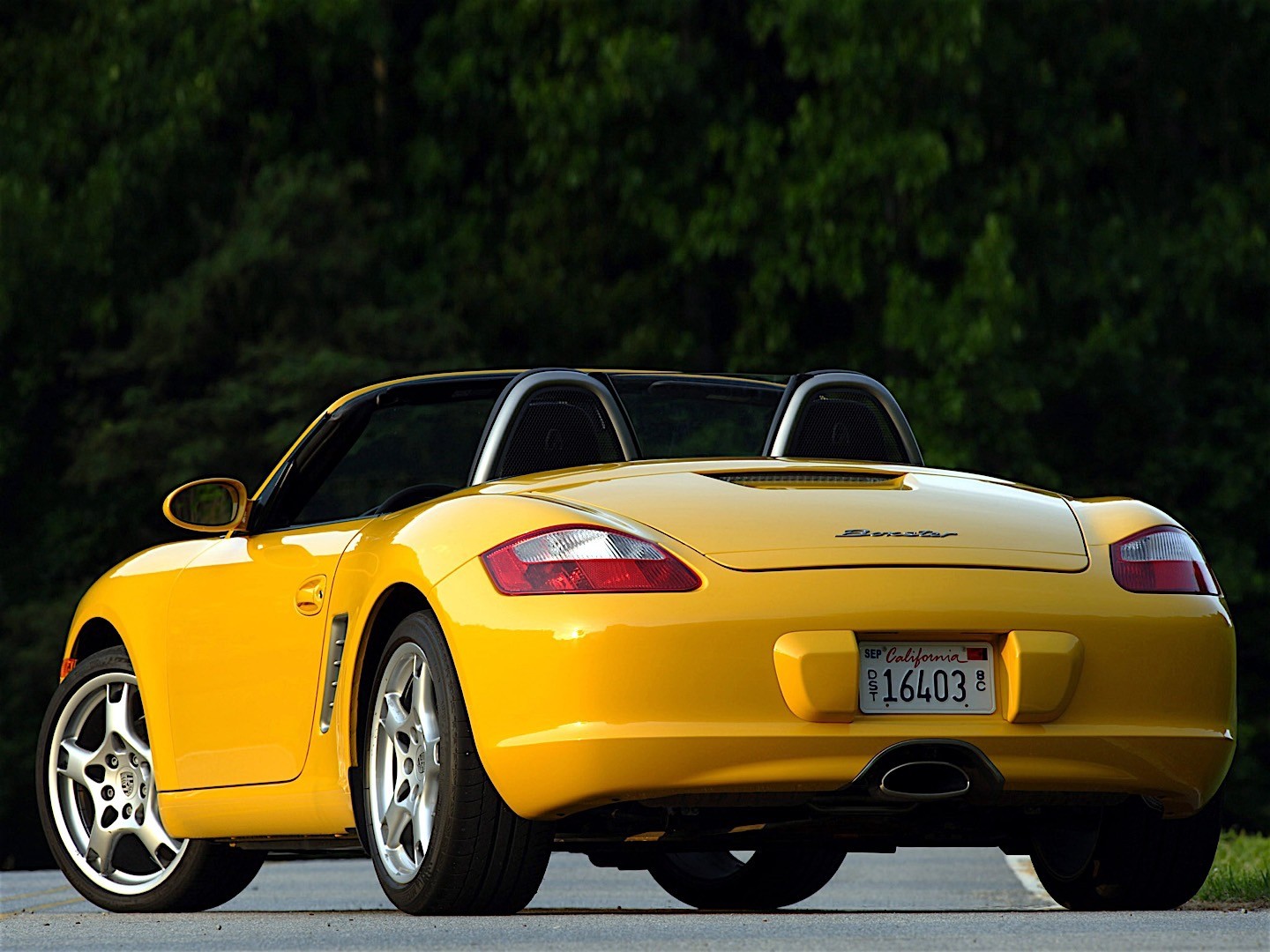(2005 – 2006) Porsche Boxster – Ultimate Guide
The original Porsche Boxster was a huge success and help Porsche grow its customer base, so when the second-generation Boxster (987) came to the US market as a 2005 model it wasn’t a surprise that it followed a similar formula. While the 987 Boxster retained only 20 per cent of the 986’s DNA, it looked similar enough to us that it felt more like a mild refresh than a totally new model update.
Truth be told, this was a revamped version of the original 986. Porsche claims that 80% of the 987 was new and while the interior and exterior were all new, the engines and transmissions were, for the most part, carry-overs, albeit with the obligatory and customary modest bump in performance for both the base (now at 2.7 liters and 240 horsepower) and the “S” version (3.2 liters with 280 hp).
One of the differences between the previous and new engines was that the new M97 flat sixes had a mechanical vacuum pump and an electronic oil management system, which did away with the beloved oil dipstick. The main difference though was that the M97 was offered with a larger and stronger single-row intermediate shaft bearing that, unfortunately, is not replaceable without splitting open the engine case.
On the outside, the 987 Boxster has a more modern and contemporary design. The interior was a much more pleasant place to be, taking a lot lessons from the new 997 model which launched the same year. The interior still pointed to the racing heritage with the presence of a tachometer which was the main dial in the instrument panel and the ignition switch was placed on the left side of the steering wheel. The leather upholstery was standard and the trims could be ordered with a choice of materials such as wood, aluminum or wood. The additions list included a Bose sound system, bi-xenon headlights and a navigation system. The base Boxster 987 came with 17-inch wheels
Pictures
Press Release
Eight years after the launch of its sensationally popular roadster, Porsche introduces the second generation of its sporty Porsche Boxster and even higher-performance Porsche Boxster S models. While this new pair of mid-engine Porsches features evolutionary design changes, the delight of the restyling is in the details, and both cars benefit from revolutionary engineering and advanced technologies.
More power, enhanced control
For the 2005 model year, engines are substantially more powerful, yet also more fuel efficient in both the Porsche Boxster and Boxster S. New five- and six-speed manual transmissions feature shorter, crisper gear changes and Tiptronic S gearboxes have been upgraded. Variable-ratio steering is standard equipment, and the steering column both tilts and telescopes to enhance driver control and comfort. Driver and passenger both benefit from redesigned and roomier interiors and four seating choices.
Wheels and tires are larger and brakes are upgraded. Porsche Stability Management becomes part of a long list of standard equipment, with Porsche Active Suspension Management, Porsche Composite Ceramic Brakes and the Porsche Sports Chrono Package added to the options list.
Safer by design
The Porsche Boxster and Boxster S have been enhanced visually and dynamically, and are the first roadsters in production with standard head-protecting airbags.
It speaks particularly well of the Porsche Boxster and Boxster S that they share nearly 55 percent of their parts – including steering, front structure, wheels, tires, seats and electrical components – with Porsche’s highly proclaimed 2005 911 Carerra.
Some 80 percent of the parts and components that comprise the second-generation Porsche Boxster were not used on the first-generation models.
Enhanced value equation
While design and engineering of the 2005 Porsche Boxster and Boxster S draw strongly on the Porsche Carrera GT and all-new 2005 Porsche 911 Carrera models, the roadsters remain attractively priced. The 2005 Porsche Boxster starts at $43,800 US and $62,400 CDN. The Porsche Boxster S, with even more power, a standard six-speed gearbox, larger wheels and other features, is priced from $53,100 US and $75,600 CDN.
Based on standard equipment levels, which now include such features as Porsche Stability Management, larger wheels and tires, Homelink, onboard computer and more, those prices actually represent significant reductions compared to the current model. Improved production techniques and sharing many parts with the 911 contribute to the new pricing and equipment strategy.
First-generation Porsche Boxster goes out in style
As the new Porsche Boxsters begin to arrive at dealerships, sales of the original roadster continue strongly. Since the introduction of the Porsche Boxster as a 1977 model, Porsche has sold over 74,000 of the vehicles in the United States, and nearly 4,000 in Canada.
Porsche had hoped to sell 15,000 Boxsters a year worldwide, but had to add a second production facility to meet the demand that has accounted for 160,000 first-generation Porsche Boxster and Boxster S units.
Redesigned, yes, but at Porsche, form always follows function
Form follows function at Porsche and the redesign of the Boxster and Boxster S is faithful to that philosophy. While the roadsters’ visual clues draw on the Carrera GT and 911 Carrera, the revised design also contributes to enhanced aerodynamics for both higher top speed and better road-holding capabilities.
The original Porsche Boxster was based on a show-stopping concept car unveiled at the North American International Auto Show at Detroit in 1993. The car drew such sustained praise that Porsche undertook development of a production model that, like the concept, rekindled fond memories of such famous Porsche racecars as the 550 Spyder and RS60.
The time finally has come for the original Porsche Boxster to be updated, though Porsche designers were careful to remain faithful to the basic cues and proportions that made the original so identifiable as both a genuine, mid-engine Porsche and a true, two-seat roadster.
Like the 911, which has retained its basic silhouette for more than 40 years, Porsche prefers to focus on the fine points of improving its vehicles rather than investing in wholesale styling changes.
Lighting the way
The Porsche Boxster’s new headlamps have the traditional Porsche look. Separating headlamps from other front lighting, which allows fog lamps to be placed lower and further from the car’s centerline, thus they are better positioned to light the way through fog or snow. At the same time, the primary headlamps are designed to enhance the driver’s lateral illumination.
Rear lighting also has been enhanced. The car’s new tail has a more muscular shape with the seam between the rear panel and the body now running above the rear lights. Instead of single elements, rear lights have three separate chambers, with a new brilliant and bright look and graphic distinction between red and white areas for an improved rear light signature in the dark. The CHMSL (center high-mounted stop light) now features 18 LEDs.
Larger windows, better view
In addition to revised lighting systems, the driver’s view of the world through which the Porsche Boxster travels – and travels quickly – improves because of other design changes. Side windows are larger and the redesigned convertible roof provides enhanced visibility at the three-quarter rear-view angle when the top is up.
Slicing through the air
Although the roadsters have increased frontal area, designers and engineers worked hard to reduce the coefficient of drag of both the Porsche Boxster and Boxster S. The result has been dramatic: The Boxster’s figures dropped from the former 0.31 to 0.29 with the Porsche Boxster S posting an 0.30 Cd compared to its predecessor’s 0.32.
The cars have a wider stance, with wheel wells enlarged to cover the larger wheels and tires that are standard on both versions of the car.
Formerly concave body sides now show some muscular bulge, door handles have been revised and the functional side scoops in each rear fender have been enlarged. To accommodate taller drivers, the roadsters have a redesigned supplemental safety bar (that extends along the outside of the rear seats down to the base of the chassis) and the car’s convertible top was reshaped to accommodate the changes.
However, carefully profiled A pillars, Carrera GT-style mirrors, a new rear spoiler and a fully covered under tray help the roadsters cut even more cleanly through the air. In addition to reducing drag, lift has been minimized at both ends of the car. As a result, the top speeds the Boxster and Boxster S can achieve on the test track increases, as does high-speed stability.
Keeping cool
Again, form follows function: clever ways were devised to incorporate into the Porsche Boxster’s redesign enhanced cooling of the engine, transmission and brakes.
Two large inlets for cooling air characterize the front air dams of both the Porsche Boxster and Boxster S. All Boxsters have a pair of front radiators, with a third unit added to a Porsche Boxster S.
To maximize cooling, ram air flaps are integrated into the corners of the front radiator frames. These flaps open when the cars reach a speed of approximately 45 miles per hour (70 km/h) and thus provide additional cooling airflow. A new highly efficient water pump moves more cooling liquid, yet is lighter in weight and allows for the installation of a more compact oil/water heat exchanger.
The undertray that manages airflow beneath the roadsters to effectively glue the car to the roadway includes flexible “blades” that also direct the air so it cools for the car’s transmission.
Enhancing brake cooling are “spoilers” installed on the front longitudinal suspension arms. These fins direct airflow to provide significantly improved cooling of the large brake discs used on the Porsche Boxster and Boxster S models.
For Porsche, it’s a total package approach
Such improvements in aerodynamics and cooling were needed because of the enhanced dynamic capabilities engineered into the second-generation Porsche Boxster. These improvements may begin with the powertrain, but a crucial part of the Porsche success formula is close attention to structure, steering, suspension and braking, the systems that provide safe control that enhances the dynamic experience for driver and passenger.
More power more efficiently
Porsche Boxsters continue to be powered by Porsche’s horizontally opposed “flat” six-cylinder “boxer” engine architecture. While engine displacement remains 2.7 liters for the Boxster and 3.2 liters for the Boxster S, both engines have been extensively revised to provide substantially more power and to provide it more efficiently.
Horsepower increases dramatically, for the Porsche Boxster from 225 a year ago to 240 (SAE) in the secondgeneration car, and for the Porsche Boxster S from 258 last year to 280 (SAE) now.
But just as impressive is the way torque is delivered right where it’s needed. The Porsche Boxster accelerates from a standing start to 60 miles per hour (97 km/h) in less than six seconds and the Porsche Boxster S accomplishes the same feat in just 5.2 seconds. But the most dramatic improvement is in pulling power for passing, even in the low-to-middle section of the rev range.
The 2.7-liter Boxster engine provides 199 pound-feet of torque while the 3.2-liter Boxster S engine generates 236 pound-feet.
With airflow carefully engineered from the air filter through the exhaust tips to maximize available torque, a Boxster driver who stands on the throttle in fourth gear finds the car responding – even without downshifting – by accelerating from 50 mph (80 km/h) to 75 (121 km/h) in less than seven seconds, and the car can continue on to double its speed – from 62 mph (100 km/h) to nearly 124 (200 km/h)- in just 22.5 seconds.
The Porsche Boxster S comes with a standard six-speed manual transmission and the same maneuver, this time in fifth gear, results in a passing sprint of just 6.8 seconds and the car needs only 19.4 seconds to leap from 62 mph (100 km/h) to double that speed.
Top speed on the test track for the Porsche Boxster is 159 mph (256 km/h) and 167 mph (268 km/h) for the Porsche Boxster S.
Air control produces power
The power enhancement runs from air filter through exhaust tip. A new and larger air filter significantly minimizes counter pressures and facilitates air intake while minimizing any water that might normally splash into the intake manifold in wet conditions.
The Boxster and Boxster S also have larger intake manifolds with a two-chamber pipe with its distributor flap moved downstream, between the cylinder banks. With the flap closed, the banks draw air separately and the engine operates like a “double” three-cylinder powerplant. At low speeds this significantly increases torque, providing greater boost from as little as 1,500 rpm.
Starting around 3,000 rpm in the Porsche Boxster and 3,500 in the Porsche Boxster S, the flap closes again and a flap in the second pipe opens, generating extra power though a resonance charge effect. Above 5,600 rpm in the Boxster and 5,500 in the Boxster S, both flaps open to provide maximum airflow. As a result, maximum torque – 199 pound-feet in the Boxster and 236 pound-feet in the Boxster S – is available from 4,700 to 6,000 rpm.
The Porsche Boxster S gets a new multi-section manifold with equal length exhaust pipes for each cylinder, improving the charge cycle and boosting engine output. On both versions of the Boxster, Porsche’s patented and heat-resistant woven-steel cushions reduce engine vibration and special bearings, designed to limit the transmission of vibrations to the Boxster’s body, connect the exhaust system to the engine.
As with the intake, the exhaust system has been redesigned to enhance airflow. Pipes have extrathin walls but larger cross-sections and move exhaust more directly to the mufflers, reducing counter pressure and allowing the engine to exhale more smoothly. Pre-catalysts are fitted directly to the exhaust manifolds. Porsche uses smaller pre-catalysts and positions them close to the engine so they heat more quickly and thus achieve their maximum efficiency. The main catalysts are now integrated to the mufflers.
Although more complex, the new exhaust system is nearly 18 pounds lighter than the previous system, thanks to the thin-wall architecture.
The new Porsche Boxster and Boxster S both meet the U.S. government’s LEV (low-emission vehicle) II emission standards.
Sound improvements
Changes to the intake and exhaust systems also fine-tune the audible emissions from the Porsche Boxster and Boxster S engines. While no louder than on the first generation, the new cars produce more muscular and powerful tones. As previously, the Porsche Boxster has a large, oval-shaped central exhaust tip while the Boxster S exhales through twin round pipes mounted at the center of the lower rear fascia.
Building a better bridge
While the Porsche Boxster engines remain largely unchanged in design, structure and configuration, the 2.7- liter engine is equipped with a new crankshaft bearing bridge, made entirely of aluminum. Formerly, the bridge was made of aluminum with cast-iron inserts. The new bridge is more than 12 pounds lighter. To cope with the additional power output from the engine, the crankshaft gets thicker, stronger bearing shells.
Porsche Boxster engine essentials
Both the Porsche Boxster and Boxster S engine continue to have four-valves per cylinder, hydraulic valve play compensation, cylinder-specific knock control and separate coils with solid-state high-voltage distributor systems. Cylinder head units comprise three parts: the actual cylinder head, complete with valves, the cup tappet housing, with hydraulic cup tappets, and the cylinder head cover.
Porsche’s VarioCam camshaft adjust technology assures maximum power on minimum fuel consumption and exhaust emissions in both city and highway driving.
The dipstick departs
Porsche Boxster engines also feature integrated dry-sump lubrication with two reflow pumps drawing oil from the cylinder heads and with a separate pump supplying oil to engine lubrication points. This setup assures optimum oil supply even under extreme dynamic conditions of high lateral acceleration. The system is so precise in monitoring oil that the engine has no dipstick; an electronic monitor indicates when oil needs to be added.
Revised five and new six-speed manual gearboxes
The Porsche Boxster’s standard five-speed manual gearbox has been improved and the Boxster S comes with a new six-speed gearbox that also is available as an option on the Boxster.
Shifter travel has been reduced by some 26 percent in the five-speed gearbox, making shifts crisp and quick. New synchromesh makes those shifts even smoother. Gearing also has been changed because of the Boxster’s larger standard rear wheels.
The new six-speed manual is standard with the Porsche Boxster S and is an option for the Boxster.
Both five- and six-speed gearboxes have reinforced synchromesh rings on all gears. As on the 911 Carrera, the synchromesh rings in first and second gear come with a wear-proof carbon coating. Formerly, the Porsche Boxster had single synchromesh on first and second gears, but now first gets triple and second double synchromesh and the Boxster S has triple synchromesh on both first and second gears and double synchromesh on third, fourth, fifth and sixth. Such multiple synchromesh assures quick and easy shifting even with short shifter travel.
Upgraded Tiptronic S
Optional on either the 2005 Boxster or Boxster S is Porsche’s Tiptronic S five-speed transmission, which has been upgraded to match the roadsters’ more powerful engines. However, even with higher gearshift pressure, the Tiptronic S offers consistent shifting.
Overall ratios have been adjusted by shortening the differential gearing on the Porsche Boxster by 8.8 percent and on the Porsche Boxster S by 4.8 percent. The gearbox also was retuned to better recognize uphill and downhill gradients and to prevent unwanted upshifts, and new transmission fluid reduced friction losses and extends fluid life to some 112,000 miles (180,000 kilometers).
New variable-ratio steering
For the first time, the Boxster and Boxster S come with standard variable-ratio rack-and-pinion steering that enhances their agility on winding roads while retaining exceptional stability at higher speeds.
When the steering wheel is within 15 degrees of center, the steering ratio remains similar to that on the previous generation. This assures a smooth and calm driving experience, even on rough surfaces where some drivers tend to make extra steering inputs. However, when the steering wheel angle exceeds 15 degrees in either direction, the ratio becomes more direct, reducing lock-to-lock and giving the driver better control both on fast, winding roads and in slow-speed parking maneuvers.
Wider track, enhanced front suspension components and geometry
While the Porsche Boxster and Boxster S continue to ride on the same basic suspension geometry that made the first generation so much fun to drive, the entire system has been updated and components optimized for strength and lightweight.
Each of the four wheels is independently mounted on a Porsche-optimized MacPherson strut/spring suspension arrangement with longitudinal and transverse control arms. This system assures precise wheel control as well as a comfortable ride.
For the second-generation Porsche Boxster, front suspension geometry has been updated to provide even better protection in an offset frontal collision.
Porsche engineers have widened the front axle by 0.59 inches (15 mm) on either side, moving axle pivot points outward and widening the car’s track by from 0.94 to 1.38 inches (24 to 35 mm) depending on the wheel and tire package. Additionally, the use of pressure-cast aluminum reduces the axle crossbar weight by more than a pound (.5 kilograms).
Lighter but stronger aluminum pivot bearings enhance steering precision and handling high lateral forces. They also provide better airflow for brake cooling, and hollow casting provides additional weight savings.
To deal with increased power and torque, wheel bearings are increased from 2.95 to 3.15 inches (75 to 80 mm) in diameter. These new bearings are not only stiffer, but, thanks to a multi-pole seal with a magnetic layer that generates speed pulses, the bearings perform the function formerly handled by anti-lock brake pulse rings.
A hydraulic bearing replaces a conventional rubber/metal bearing to connect longitudinal and transverse suspension arms, providing an even more comfortable ride by absorbing vibrations caused by rough road surfaces.
Porsche engineers also reset springs, shocks and supplemental safety bars to match the new chassis and larger wheels to assure a dynamic driving experience without any decline in ride comfort.
Stiffer but lighter rear suspension
Engineers set a target of putting the second-generation Boxster and Boxster S on a rear suspension that is stronger but lighter while increasing transverse stiffness. The suspension thus can deal with even higher forces of lateral acceleration and provide an even more comfortable ride quality.
One significant change is the carrier element on the subframe, now made of pressure-cast aluminum. This reduces weight by more than two pounds (nearly one kilogram).
Axle kinematics are optimized in conjunction with the tie bar mount, improving response and agility. New and longer two-sleeve shock absorbers enhance camber stiffness and vehicle response.
A longer pivot lever on the aluminum wheel mount provides greater toe-in stiffness and more precise wheel control. Camber stiffness also has improved – by 30 percent. Hollow casting of the wheel mount reduces weight by 2.6 pound (1.2 kilograms).
Porsche Active Suspension Management available
Porsche introduced PASM – Porsche Active Suspension Management technology – on the 2005 911 Carrera and this adaptable system is available as an option on the new Porsche Boxster and Boxster S.
PASM provides two suspensions in one: a sporting but comfortable setup for normal use and a very dynamic setup such as that which would be used in performance-driving situations.
By pressing a button on the center console, the driver can switch from PASM “Normal” to PASM “Sport.” The PASM suspension lowers the car by 0.39 inches (10 mm) compared to the standard suspension setup. When switched into its sport setting, PASM activates a firmer damper control map to provide extreme agility and dynamic control that minimizes body roll.
In testing at Germany’s famous Nurburgring racing circuit, a Porsche 911 Carrera equipped with PASM and set in the Sport mode produced lap times an average of five seconds faster than with the standard 2005 suspension setup.
There are advantages to PASM even when left in its normal setting, as it automatically adjusts to changes in driving style, gradually becoming firmer to respond to greater dynamic forces.
The PASM system combines continuously adjustable shock absorbers, a pair of accelerometers – one in the front right damper dome, the other in the left rear – that determine vertical movements of the car’s body and an electronic control unit that also has access to steering angle, road speed, brake pressure and engine torque figures and thus can provide optimum damper control for each wheel through the active dampers that have a similar structure as standard shocks, providing damping with oil pressure, but that also have a bypass valve that opens and closes to increase or reduce the oil flow as needed. (Should the system fail, the bypass valve automatically closes, putting PASM into its hardest position to assure the safety dynamic driving mode.)
Dynamic modules for any driving situation
PASM is equipped with five special software modules – lane change, vertical control, lateral acceleration, brake and load change – to provide optimum settings for any driving condition.
Lane change module: In response to rapid movements of the steering wheel in a sudden maneuver, the system instantaneously increases damper forces on both axles, reducing any tendency toward sway or rocking.
Vertical control module: In the normal program, damper forces increase whenever vertical movement of the car’s body exceed a threshold, for example, when driving on a bumpy surface. This prevents any risk of the body starting to rock. However, when in the sport program, the system reduces the damping effect to maintain wheel contact with a rough surface, preventing the risk of the car “jumping” around.
Lateral acceleration module: In the normal program, damping varies through a curve, adjusting with road speed and lateral acceleration.
Brake module: As soon as the driver applies the brakes, PASM firms damping to reduce body dive, ensuring faster transmission of brake forces to the road. Then, at a certain point in the braking process, the system switches to softer damping, with different forces applied in the front and rear of the car. This ensures better surface contact and shortens stopping distances, even on rough roads.
Load change module: In all-out acceleration, with the driver lifting off the accelerator while shifting gears, the control maps are adjusted for the front and rear axles. In the normal mode, harder damping is used briefly to prevent too much squat. In the sports mode, a softer damper response is used to improve traction, for example, on a rough road surface.
Upgraded Porsche Stability Management is standard equipment
All second-generation Porsche Boxster and Boxster S models are equipped with enhanced Porsche Stability Management (PSM) as standard equipment. PSM is a computerized system that uses the sensors for ABS (anti-lock braking), ASC (anti-spin control), EDC) (engine drag control) and ABD (automatic brake differential) and intervenes to help the driver keep the car on its intended path rather than sliding too far sideways, say in a fast and tight turn.
To provide the driver with more latitude in slower curves, PSM intervenes later when the vehicle is traveling at a rate of less than 50 miles per hour (70 km/h).
The driver can deactivate the system with a switch and the system stays off until the driver applies the brakes. However, with enhanced PSM, the system doesn’t reactivate until the driver presses firmly on the brakes, reaching the ABS threshold on at least one front wheel.
Sport Chrono Package Plus
Available on the new Porsche Boxster and Boxster S is the Sport Chrono Package and the Sport Chrono Package Plus, which incorporates the display screen from the optional Porsche Communications Management system.
Introduced on 2005 Porsche 911 Carrera or 2005 Porsche 911 Carrera S, the Sport Chrono options allow the driver to engage more aggressively set electronic management system control maps and also includes a stopwatch gauge on the instrument panel. The system is designed particularly for track and autocross-style events.
The Sport Chrono Package and Sport Chrono Package Plus also enable revised intervention thresholds for PSM.
By pressing a button on the center console, the driver engages Sports Chrono to take driving dynamics to a standard never before available. The Sports Chrono options effect changes to the gas pedal control lines, engine speed limiter, engine throttle butterfly, PSM, PASM and Tiptronic S.
When the Sports telltale lights up on the center portion of the gauge cluster, the driver knows that the E-gas control line has switched to a steeper configuration that puts the Tiptronic S in its manual mode, thus the throttle butterfly responds more quickly to movements of the gas pedal and the driver enjoys even more spontaneous response from the engine. Should the driver keep the accelerator pedal fully depressed without shifting gears, the engine speed limiter in gears 1-5 intervenes far more abruptly than in routine driving. Shifts become less oriented to comfort and the throttle butterfly closes faster when the driver lifts off the accelerator pedal, thus providing a more dynamic driving experience, more similar to the feedback a racer gets from a car on the track.
The operation and intervention of PSM also changes to provide greater agility. For example, when accelerating out of turn in the Sports mode, higher anti-spin control thresholds allow more slip from the rear wheels. This can result in even faster acceleration because PSM does not intervene as quickly. Likewise, other PSM thresholds, such as those that control the anti-lock braking system, are raised to a level that allows more dynamic control by the driver before the system intervenes. And the particularly skilled driver retains the option of switching off the PSM system and taking full manual control of the car’s dynamic direction.
Under the Sport Chrono Package and Sport Chrono Package Plus, the PASM also switches automatically when needed to a sports program that provides firmer suspension settings, reducing even further any body lean through corners and enhancing contact between the tires and the road surface. However, there are circumstances, such as on wet or snowy roads, in which an aggressive driver knows that a “softer” suspension setting can enhance traction and thus the PASM button can be pushed to put the car in its normal setting even when the sports mode is active.
The “Chrono” includes a stopwatch and lap-counting function. So the driver can graphically verify the improved dynamics of the second-generation Porsche Boxster and Boxster S, the driver can push a stalk attached to the left side of the steering column to record various route segment times, which can be reviewed graphically on the optional PCM screen.
Larger wheels, new-generation tires
Second-generation Porsche Boxsters ride on 17-inch wheels and the Boxster S comes standard with 18-inch wheels. Optional on either vehicle are 19-inch rims.
Porsche Boxster wheels now are made from a flow-forming process that provides for strong but lightweight wheels and thus the installation of larger tires.
The Porsche Boxster comes with wheels that feature a forked, five-spoke design. Wheels are 6.5 inches wide in front and eight inches wide in the rear. All tires are Z-rated radials, 205/55 aspect in front and 235/50 in the rear.
The Porsche Boxster S rides also rides on forked, five-spoke wheels, though the design is different from the Boxster pattern. The front wheels are eight inches wide and the rears are nine inches wide. Tires are 235/50 aspect in front and 265/40 in the rear.
Three 19-inch wheels are available as options. All are eight inches wide in front and 9.5 inches wide on the rear axles. Two of the wheels are similar to those on the 2005 Porsche 911 Carrera while Boxster “sport” wheels features a 15-spoke arrangement. The larger wheels enhance vehicle dynamics and also shorten stopping distances.
Tires on the new Boxster and Boxster S are of the latest generation and thus can handle increased forces, both longitudinal and lateral. The tires larger roll circumference provides an increased sidewall height to tire width ratio for a comfortable yet athletic ride.
Spare tire deleted
To save 22 pounds (10 kilograms) per car, and to provide additional room for luggage, secondgeneration Boxster and Boxster S models are not equipped with a spare tire or a jack for changing tires. Instead, the cars are equipped with an electrical air compressor and emergency tire sealant. Thus damage such as that caused by a nail in the tread can be temporarily repaired by using the tire sealant and re-inflating the tire.
However, Porsche reminds drivers not to exceed 50 mph (80 km/h) on a tire with a temporary repair and to have the tire replaced or professionally repaired as quickly as possible.
Enhanced brakes
Brakes have been updated on both the Porsche Boxster and Boxster S. For the first time, the Boxster is equipped with cross-drilled front discs. They are 11.73 inches (298 mm) in diameter and 0.94 inches (24 m) thick. The more powerful Boxster S gets even larger front brakes (also cross-drilled for better cooling), measuring 12.52 inches (318 mm) in diameter and 1.10 inches (28 mm) thick.
All second-generation Porsche Boxster discs are stopped by four-piston, aluminum monobloc calipers, which are black on the Boxster and red on the Boxster S.
To reduce the force required on the brake pedal and to expedite brake response, brake power assist is boosted by 18 percent to provide a consistent, fatigue-free and spontaneous system.
Like the 2005 Porsche 911 Carrera, the second-generation Porsche Boxster has a mechanically driven vacuum pump and supplies pressure to the brake servo rather than a conventional suction jet pump within the engine intake manifold. Driven by the exhaust cam on the right-hand cylinder bank, this pump provides a high and consistent level of power, even in low ambient air pressure or high altitude conditions and during highly dynamic driving conditions under mostly open throttle.
Porsche Ceramic Composite Brakes available
For the first time, the Porsche Boxster S is available with Porsche Ceramic Composite Brakes (PCCB). Because of their exceptional performance in extreme conditions, ceramic composite brakes were developed for use in high-level motorsports competition. Porsche was the first automaker to apply them for road use, with Porsche Ceramic Composite Brakes included as standard equipment in the Carrera GT and the 2005 Porsche 911 Turbo S coupe and convertible.
Instead of metal, the 13.78-inch (350 mm) brake discs are a ceramic material that provides high and consistent levels of friction during application. They also weigh approximately 50 percent less than metal discs and thus reduce unsprung mass by 34.4 pounds (15.6 kg) per car.
The newest generation of Porsche Ceramic Composite Brakes is even more rigid, yet include more interior cooling ducts. Fiber reinforcement on the friction surface is increased, significantly enhancing resistance to abrasion under high loads.
Stiffer, stronger structure
The Porsche Boxster and Boxster S always have been known for their stiff and stable body structure, but the new generation cars are even stronger. Torsional stiffness has increased 9 percent while resistance to flex has improved by 14 percent. Yet even with more standard equipment, including larger wheels and tires, the new Boxster weighs in at a mere 44 pounds (20 kilograms) heavier than its predecessor. Of that weight, nearly 40 pounds (18 kilograms) is attributable to the stronger body in white (the naked chassis without doors).
To compensate for some of that additional body weight, the luggage compartment hoods are made from aluminum and lighter but effective insulation materials are used.
The front structural section of the car is now made from extra-strength steel and has been designed to enhance occupant safety in a frontal collision. A bonus is the provision for more room ahead of the occupants, both in the front storage compartment and in the passenger foot wells.
As a dividend of the extra space, gas and brake pedals have been moved forward by nearly fourtenths of an inch (10 mm) and the clutch pedal by six-tenths of an inch (15 mm), making the car more accommodating to taller drivers.
Tailored blanks formerly used for the rear under chassis structure now are used at the front as well. These blanks are made from different types of steel laser-welded into a single, ultra-strong but lightweight unit engineered to deform in a defined manner to maximize occupant protection in a frontal collision.
The so-called upper load path that directs the force of a frontal impact around the upper portion of the passenger compartment – through the doors and to the rear of the vehicle – also has been optimized. Doors are reinforced and a support tube of ultra-strong steel extends from the lower bulkhead crossbar to the A-pillar. Nicknamed the “hockey stick” because of its shape, this tube further strengthens the passenger cell.
New hydroformed supplemental safety bar
Providing additional structure is a new and taller supplemental safety bar made of stainless steel alloy. The new supplemental safety bar is nearly an inch (25 mm) higher than on the first generation and has been moved 1.22 inches (31 mm) toward the rear. With seats mounted in a lower position and with headrests extended nearly two inches (50 mm) higher, the second-generation Boxster provides occupants with a considerably larger survival area.
First roadster with head airbags
The second-generation Porsche Boxster and Boxster S are the first roadsters to go into production with head airbags.
All Boxsters are equipped with three-point inertia-reel seat belts with belt-latch tensioners and beltforce limiters as well as six airbags. In addition to frontal airbags, the Porsche Boxster and Boxster S feature the Porsche Side Impact Protection (POSIP) system with a thorax-protecting airbag at the outside of the seat backrest and with large head airbags in the door window sills.
Redesigned convertible top
Although redesigned to fit over the taller supplemental safety bar and to provide more room for taller drivers, the convertible top is lighter and thus helps lower the center of gravity of the new Boxster and Boxster S.
The frame for the roof is made from aluminum and magnesium. The roof uses light synthetic fleece fiber for improved noise and heat insulation and has an electrically heated rear glass window.
The convertible top is power operated and can be opened or closed even while the car is moving at speeds up to 31 miles per hour (50 km/h).
A three-piece wind deflector is available and is larger than on the first-generation cars. Also available is a removable aluminum hardtop that weighs only 51 pounds (23 kilograms).
New ambience inside
The interior of the second-generation of Porsche’s roadster has been completely redesigned. The dashboard, interior door panels and the sides of the center console are covered in a special and durable material that looks much like leather.
The gearshift lever, steering wheel rim, handbrake lever handle and door handles are covered with leather. On the Porsche Boxster S, the cover on the storage box in the center console and those on the storage pockets in the doors are covered in leather.
Aluminum-look trim is used around air vents and on the gearshift lever.
The second-generation Boxster also offers a second 12-volt power outlet on the passenger’s side of the center console. A pair of cupholders is integrated into the dashboard and is hidden behind a trim strip when not in use.
Column tilts and telescopes
In addition to the new variable ratio steering gear, the new Porsche Boxster and Boxster S have steering columns that both tilt and telescope to better fit every driver. The new tilt feature allows the steering wheel position to move by 1.57 inches (40 mm). Taller drivers also benefit from the slightly higher roof profile, lower mounting of the seats and from pedals being moved slightly closer to the front firewall.
Three new steering wheels
Attached to that tilting and telescoping steering column is one of three new steering wheels.
The standard wheel has a three-spoke design. It is 14.76 inches (375 mm) in diameter and is built around a composite magnesium skeleton that reduces weight by 10 percent compared to the aluminum frame formerly used.
The optional sports wheel is just 14.57 inches (370 mm) in diameter with ergonomically contoured grab recesses on the rim to accommodate dynamic driving maneuvers.
Also available and in conjunction with the Porsche Communication Management system is a multifunction wheel that allows the driver to operate audio, navigation and telephone functions by six function keys built into the steering wheel. The keys are embedded into aluminum-look trim panels.
Four seating choices
The second-generation Porsche roadster comes with four seating choices:
- The standard seats can be adjusted in six directions, with power travel for seat and back angle and manual fore-aft and height adjustment. Height adjustment is provided by a newly developed step mechanism fitted between the seat and side-sill. Compared to the seats in the first-generation Boxster, the new standard seats offer 50 percent more side support.
- Full power seats are adjustable 12 ways and include a pneumatic lumbar support with two inflating air cushions. The memory function on the driver’s seat includes the lumbar inflation setting.
- Sports seats are based on the standard seats but provide even more side support for dynamic driving, in the seat and back cushions and also around the shoulder area.
- Adaptive sport seats combine the benefits of full electric adjustment and enhanced lateral support. These seats also allow individual adjustment of the various side supports.
Bi-color leather is available as an option.
Lower seating position and improved ergonomics
All seats in the second-generation Porsche Boxster and Boxster S are mounted as low as possible, thus helping to lower the center of gravity and enhance driving dynamics. This lower seating position also increases the available headroom when the convertible top covers the passenger compartment.
Lightweight technology enables Porsche engineers to develop seats that are no heavier than those used previously, but are stronger and more stable and that have taller backrests with thorax airbags mounted within the seat.
Porsche also has developed a patented vibration dampening system for its seats.
Updated instrument cluster
While the large tachometer continues to dominate the central spot on a three-gauge instrument cluster, the gauges have been moved further apart to provide enlarged and easy to read displays. Readability also improves in low-light conditions with LEDs in white rather than yellow.
Road speed is presented in both analog and digital formats with rpm, fuel level, coolant temperature, odometer, clock and outside temperature displays providing the driver with important information.
Cars equipped with the Sports Chrono system have that readout in a dot matrix display in the lower third of the rev counter.
The Porsche Boxster has blackface gauges with light gray gauges in the Boxster S.
New center console design
A new and eye-catching center console descends from the center of the instrument panel, just beneath the center pair of new, vertically oriented oval air outlets. Designers have upgraded all switchgear, including window controls mounted in the doors, with small “finger strips” that facilitate manipulation of the various control functions.
The Porsche CDR 24 CD radio has a larger control surface for easier use and is illuminated by white LEDs. The system includes two tweeters in the instrument panel with a woofer in each door.
Optional is the Porsche Sound Package Plus with seven speakers and an external analog amplifier, two tweeters and a subwoofer in the instrument panel as well as a subwoofer and woofer in each door.
Also available is a Bose Surround Sound system with 11 speakers and a seven-channel digital amplifier.
Porsche Communication Management
Optional on both the Boxster and Boxster S is the enhanced Porsche Communication Management (PCM). New features for PCM include a DVD-based navigation system as separate optional module, located in the luggage compartment. This allows the CD drive on the PCM to be used exclusively for audio CDs.
The upgraded and DVD-based optional navigation module is much faster than the former CD-based system and allows rapid availability of routes and map updating, as well as 23 zoom stages up to a minimum resolution of some 55 yards (50 meters). Information is displayed on a 5.8-inch color monitor.
More storage space
Among the Porsche Boxster’s unique features are two luggage compartments, one at the front of the car and another behind the seats. An added benefit of the Boxster’s architecture is that its convertible top system takes up none of the car’s available storage area even when the top is down.
The front luggage compartment offers even more space in the second-generation Porsche Boxster with a capacity of 5.29 cubic feet (150 liters). The rear compartment offers another 4.59 cubic feet (120 liters), expanding storage area to a total of 9.98 cubic feet (270 liters).
Impressive list of options
Options available on the Boxster or Boxster S include Bi-Xenon headlamps and Park Assist that uses ultrasound to measure the distance to the nearest obstacle and warns the driver as appropriate, Porsche Active Suspension Management, Porsche Communication Management and Sport Chrono Package.


